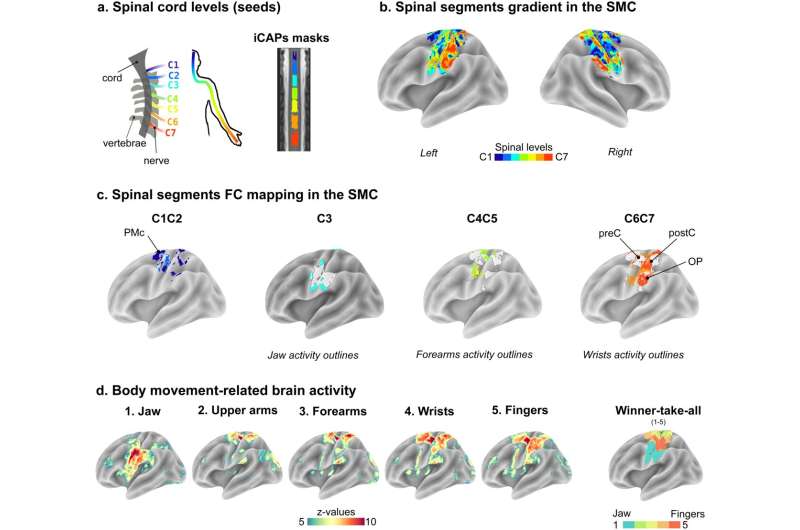This article has been reviewed according to Science X's editorial process and policies. Editors have highlighted the following attributes while ensuring the content's credibility:
fact-checked
trusted source
proofread
Research team successfully maps the brain-spinal cord connection in humans

The brain and spinal cord are the central pillars of the human central nervous system (CNS), orchestrating everything from movement to sensation. Despite significant advances in neuroscience, our understanding of how these two crucial components of the CNS interact remains limited.
A comprehensive view of the entire CNS will bolster the development of therapies for neurological disorders, particularly those involving both the brain and spinal cord, such as spinal cord injuries and neurodegenerative diseases.
Bridging this critical knowledge gap, researchers at EPFL's Neuro X Institute, UNIGE's Department of Radiology and Medical Informatics, and McGill University's Montreal Neurological Institute (The Neuro) have developed a tool to significantly advance our understanding of the CNS organization.
Their new study, published in Imaging Neuroscience, successfully maps the functional connectivity between the brain and spinal cord in humans, providing a more detailed view of how these two critical components interact.
"This research allows us to see the CNS as a whole, which is crucial if we want to develop effective therapies that target complex neurological conditions. The imaging tool—a set of technologies and protocols—greatly improves our understanding of somatotopic organization.
"This means that we can now see how different parts of the body are mapped onto specific areas of the brain and spinal cord," says Dimitri Van De Ville, head of EPFL's Medical Image Processing Laboratory (MIP:lab) and one of the lead authors of the study.
The CNS network down to the smallest detail
This breakthrough, achieved through a detailed analysis of simultaneous brain and cervical spinal cord functional magnetic resonance imaging (fMRI) data, provides unprecedented insights into how the brain and spinal cord work together to represent the body as a whole. What emerges is a body map that extends across the different levels of the CNS.
Building on prior research in functional imaging techniques developed at the MIP:Lab, researchers used algorithmic models to isolate and identify specific regions of interest in both the brain and spinal cord. For the spinal cord, this approach allowed accurate delineation of the spinal segments responsible for innervating different body parts, enhancing our understanding of the organization within the spinal cord itself.
To explore how the brain and spinal cord interact, the researchers employed functional connectivity analyses. By examining synchronized activity between the brain and spinal cord, they were able to uncover how specific areas in the brain and spinal cord correspond to different parts of the body. This approach provided a detailed map of the networks that connect the brain and spinal cord, offering new insights into how the central nervous system operates as a unified whole.
A methodological framework for future progress
"Our findings show that even at rest, the brain and spinal cord maintain a precise map of the body," says Nawal Kinany, co-first author of the paper. "The methodological framework introduced in this study can also be deployed in clinical populations, for instance to investigate CNS reorganization after lesions or limb amputation. In the future, this knowledge could contribute to the development of more accurate treatments and interventions, ultimately improving patient outcomes."
Another key innovation lies in the researchers' ability to overcome the technical challenges of imaging two anatomically distinct parts of the central nervous system at the same time, which traditionally require separate scans.
The data for the study were collected at the The Neuro in Montreal, under the supervision of Julien Doyon, a leading researcher in the field and a key collaborator on the project. His expertise in neuroimaging and the lab's state-of-the-art facilities were crucial in capturing the high-quality fMRI data that made this detailed mapping of brain-spinal cord connectivity possible.
By integrating cutting-edge imaging techniques and collaborative research, the findings provide a foundational framework for future explorations into CNS function and dysfunction.
More information: Caroline Landelle et al, Cerebro-spinal somatotopic organization uncovered through functional connectivity mapping, Imaging Neuroscience (2024). DOI: 10.1162/imag_a_00284



















